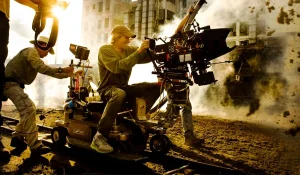Thomas Alva Edison is widely known as the inventor of the incandescent light bulb—an icon of innovation in the world of electricity. However, few people know that behind his reputation, Edison also played an important role in the early history of cinema. He contributed to the creation of a device that enabled images to be recorded in sequence and enjoyed by the public, paving the way for what we now know as film.
Motion pictures, which are now at the heart of the global entertainment industry, originated from a series of scientific experiments and breakthroughs in visual technology. One of the key figures who paved the way was Eadweard Muybridge—whose invention, the Zoopraxiscope, may be familiar to cinema enthusiasts.
This device allowed us to see images as if they were moving, but it still had limitations: the images had to be manually redrawn on glass discs, making mass production difficult. This was the gap that Edison saw—and from it, an important innovation was born.
From Experiment to Innovation: Kinetoscope

Inspired by Muybridge’s experiments, Edison began developing a device that allowed people to see moving images not from paintings, but from actual camera captures. Together with his assistant, William Kennedy Laurie Dickson, in 1891 they introduced the Kinetoscope—a device that became one of the precursors of modern film.
Unlike the Zoopraxiscope, which used glass discs, the Kinetoscope worked by rotating a perforated celluloid film strip through a system of lights and lenses. Viewers could see moving images through a small window at the top of the device. The film format used, 35mm, was also developed by Edison’s team—and remarkably, it remains the industry standard to this day. However, the experience it offered was still individual. Each person had to peek into the device to enjoy the short films being shown.
Black Maria: The World’s First Film Studio

To supply content for the Kinetoscope, Edison built Black Maria, the first film studio in the United States, in 1893. It was here that various short films were produced—from exotic dance performances and athletic feats to short plays.
Some of the famous films from this studio include Fred Ott’s Sneeze (1894), The Kiss (1896), and various entertainment performances such as circuses and boxing matches. But don’t imagine films of the length we have today. At that time, films only lasted around 20 to 60 seconds. Despite their brevity, these films serve as evidence that technology could capture reality and present it anew in the form of moving visuals.
Edison and the Legacy of Technology in Cinema
Edison’s contribution to the world of cinema did not lie in aesthetics, but rather in the development of technological devices that made moving images widely accessible to the public. He refined Muybridge’s basic idea and turned it into a product that could be reproduced, commercialized, and enjoyed consistently. Through the Kinetoscope, the 35mm format, and the establishment of the Black Maria, Edison laid the technical foundation that allowed cinema to evolve into both an art form and a global industry. He served as a bridge between 19th-century scientific experiments and the entertainment world of the 20th century.
Thus, although he is better known for his achievements in electricity, Thomas Alva Edison’s name also deserves to be mentioned as one of the key figures in the history of cinema. If Muybridge was the scientist who conceived the illusion of motion, then Edison was the technocrat who made that illusion a reality and accessible to the general public. Without the contributions of these two figures, the big screen that is now so familiar to our daily lives might never have come into existence.
Edison’s legacy also lives on in the way we enjoy films today—projection technology, film reel length, and the concepts of studios and mass distribution are all rooted in the foundations he laid. He was not a visual artist, but he equipped artists with the tools to bring their ideas to life in a new form: cinema. So, who was the first to introduce aesthetics into cinema?
The answer will be explored in our next article here!




